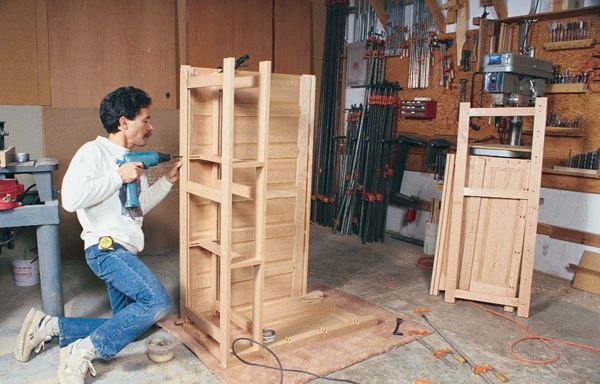Large-Case Construction Strategies
Simplified joinery and a solid plan keep big jobs under control
Synopsis: Bruce Cohen has a way to simplify projects like his nine-drawer dresser, which has more than 100 parts and even more joints. In this article he explains how to limit the details you keep in mind and how to break the process into manageable steps. He says keeping multiple detailed drawings and cut lists keep him sane. He keeps as much as possible consistent from project to project, too, so the drawings aren’t cluttered with anything other than unique elements. He shares his method of dimensioning stock accurately and quickly and simplifies dado-and-tenon joinery to save confusion and time by cutting them all at once. Cohen assembles the dresser by dividing it into a number of smaller frames. Then he assembles the frames into the complete case. He uses undersized dowels when dry-fitting to set up a calm but quick glue-up.
Tackling big jobs like my nine-drawer dresser used to be a nightmare. It has well over 100 parts and even more joints, but through the years, I’ve developed a few strategies that make the process a smooth and enjoyable one. I limit the number of details I have to keep in mind and break the process into easily manageable steps. With my tactics, I’m able to get the most out of my time, techniques and materials. I also get a little more sleep.
I use quick but accurate drawings and cut lists to make sure that my projects are well organized even before I mill the first board. I dimension all the parts at once and cut my simplified joinery with only a few machine setups. Parts are always neatly stacked, clearly marked and easily found. I first build small sections that are easy to handle and then bring them together in a final sturdy case. Assembly and glue-up becomes a rewarding and almost leisurely task.
Drawings and cut lists help to keep you sane
Shop drawings are the only way I know to keep the details of a large case under control. I first use the drawings to figure out the dimensions of each part, and then a final drawing helps me compile cut lists (see the photo at right). During milling and construction, I refer to the drawings and the cut lists constantly. To do otherwise with so many parts to keep track of would introduce errors and would risk endless confusion.
I reduce the potential for much confusion by making many details common to every case I make. These include the stock thicknesses, the tenon lengths and the panel thicknesses. I keep these details in my head so I don’t clutter my shop drawings with them. Only what’s unique to the piece gets put in the drawings.
I always draw an isometric view of the front and one side, an elevation of the back, and a top view. Often I’ll add views of selected internal frames, just to make sure I keep them straight. I like to keep all drawings on a single sheet attached to a clipboard so that they’re easy to check while I work.
Once I have a shop drawing, I can calculate the dimensions of each piece. I then make two cut lists. One is organized around each section of the case (sides, back, internal frames). This list tells me what goes where and what joints to cut on which pieces.
From Fine Woodworking #131
For the full article, download the PDF below:
Fine Woodworking Recommended Products

Bessey EKH Trigger Clamps

Dubuque Clamp Works Bar Clamps - 4 pack

Bessey K-Body Parallel-Jaw Clamp






















Log in or create an account to post a comment.
Sign up Log in